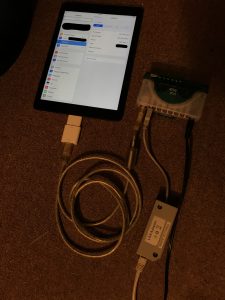For various reasons, you might end up needing to hook up your iOS device directly to an Ethernet network without using Wi-Fi. For example, maybe you’re in an area with bad Wi-Fi reception. Or perhaps you are trying to do something that requires high bandwidth and your Wi-Fi access point doesn’t have the best speed.
Well, it turns out that iOS has supported Ethernet for a while. Obviously your iOS device doesn’t have an Ethernet port, so you have to use a USB-to-Ethernet adapter. As of iOS 10.2, there is even a settings screen that appears when you plug in a supported adapter. Older versions of iOS apparently still supported Ethernet, but didn’t provide a screen for setting it up, so you were probably stuck with the default settings (grabbing an IP address from a DHCP server). Now that there is a setup screen, you can configure it exactly how you want.
I tested it out with three devices tonight, and they all worked flawlessly: iPhone 6, iPhone 7, and iPad Air.
You might ask: how do you plug in a USB device given that iOS devices don’t have USB ports? The answer to that question is that Apple has for a long time sold various adapters that allow you to plug in your camera to download pictures. Such an adapter provides a USB port, and it is exactly what you need. For iOS devices with the 30-pin connector, the product was called the iPad Camera Connection Kit (now discontinued). However, I’m not sure that iOS devices that old will support Ethernet anyway. For iOS devices with a Lightning connector, Apple sells the Lightning to USB 3 Camera Adapter and the Lightning to USB Camera Adapter.
Because I don’t own a Lightning to USB Camera Adapter, I ran my test using a combination of intermediate adapters: a Lightning to 30-pin Adapter and the 30-pin to USB adapter from the iPad Camera Connection Kit. As for the USB-to-Ethernet adapter, I used a generic USB-to-Ethernet adapter that I use with my Nintendo Wii U (it has the ASIX AX88772 chipset). You can find these available for less than $10 on Amazon.
When I first plugged it into my iPhone 7, nothing happened. After waiting for a while and unplugging and replugging it a few times, the following error finally popped up:
Cannot Use Device
AX88772 : The connected device requires too much power.
So iOS devices, at least the ones I tested, can’t power a USB-to-Ethernet port directly. I ended up plugging the Ethernet adapter into a powered USB hub, and then plugging the hub into the iPhone through the adapters. If you have a Lightning to USB 3 Camera Adapter, it provides another Lightning port you can use for supplying power with your iPhone/iPad charger instead of a powered hub.
After powering the adapter properly, a new “Ethernet” section appeared in my Settings app. It seems to be organized in such a way that multiple USB-to-Ethernet adapters can be connected simultaneously through a hub. It allows you to fully customize the IP configuration just like you can do with Wi-Fi networks. Pretty cool! Here’s a picture of the settings screen in action on my iPad Air:
That’s really all there is to it. Pretty simple! I was pleasantly surprised that a generic USB-to-Ethernet adapter I had laying around worked with no trouble. I was also happy that the old iPad Camera Connection Kit was still compatible with newer iOS devices using a Lightning to 30-pin Adapter.





no comments